Abstract
Several congeners of methylglyoxal bis(guanylhydrazone) were tested for their ability to inhibit eukaryotic putrescine-activated S-adenosylmethionine decarboxylase (EC 4.1.1.50) and intestinal diamine oxidase (EC 1.4.3.6). All the compounds tested, namely methylglyoxal bis(guanylhydrazone), ethylglyoxal bis(guanylhydrazone), dimethylglyoxal bis(guanylhydrazone) and the di-N"-methyl derivative of methylglyoxal bis(guanylhydrazone), were strong inhibitors of both yeast and mouse liver adenosylmethionine decarboxylase activity in vitro. The enzyme from both sources was most powerfully inhibited by ethylglyoxal bis(guanylhydrazone). All the diguanidines likewise inhibited diamine oxidase activity in vitro. The maximum intracellular concentrations of the ethyl and dimethylated analogues achieved in activated lymphocytes were only about one-fifth of that of the parent compound. However, both derivatives appeared to utilize the polyamine-carrier system, as indicated by competition experiments with spermidine.
Full text
PDF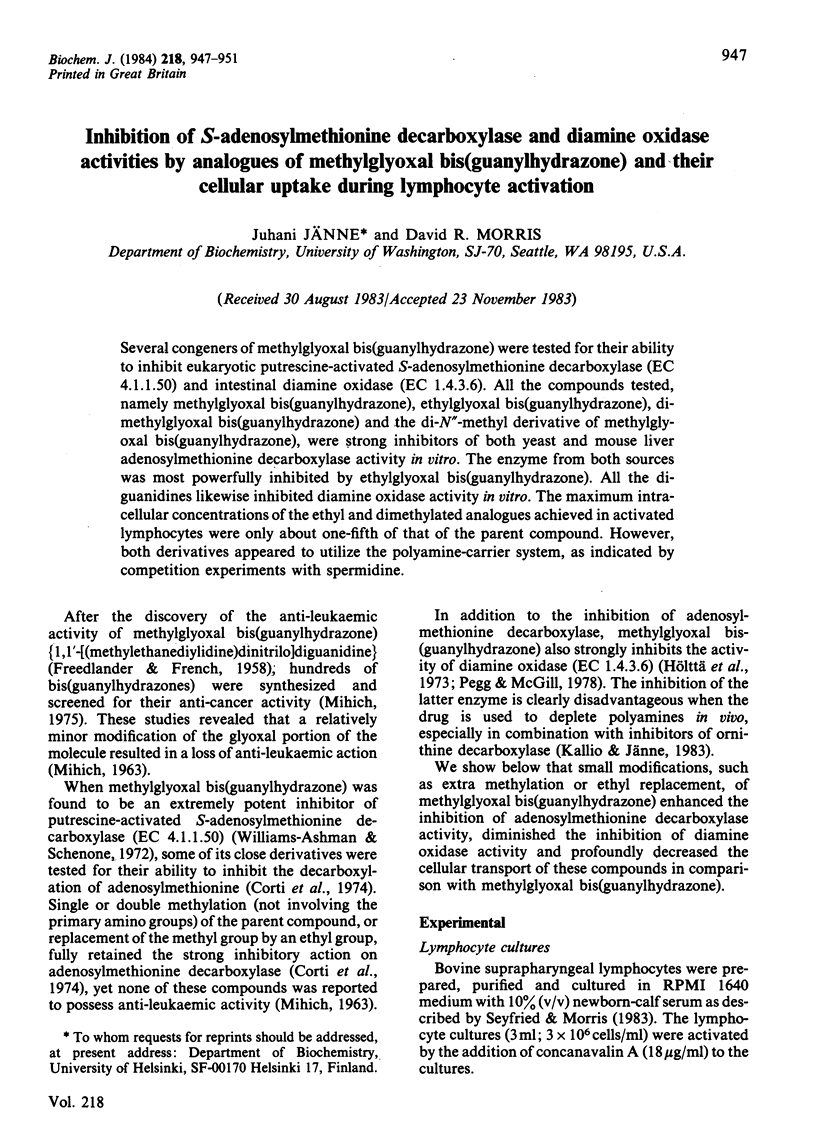
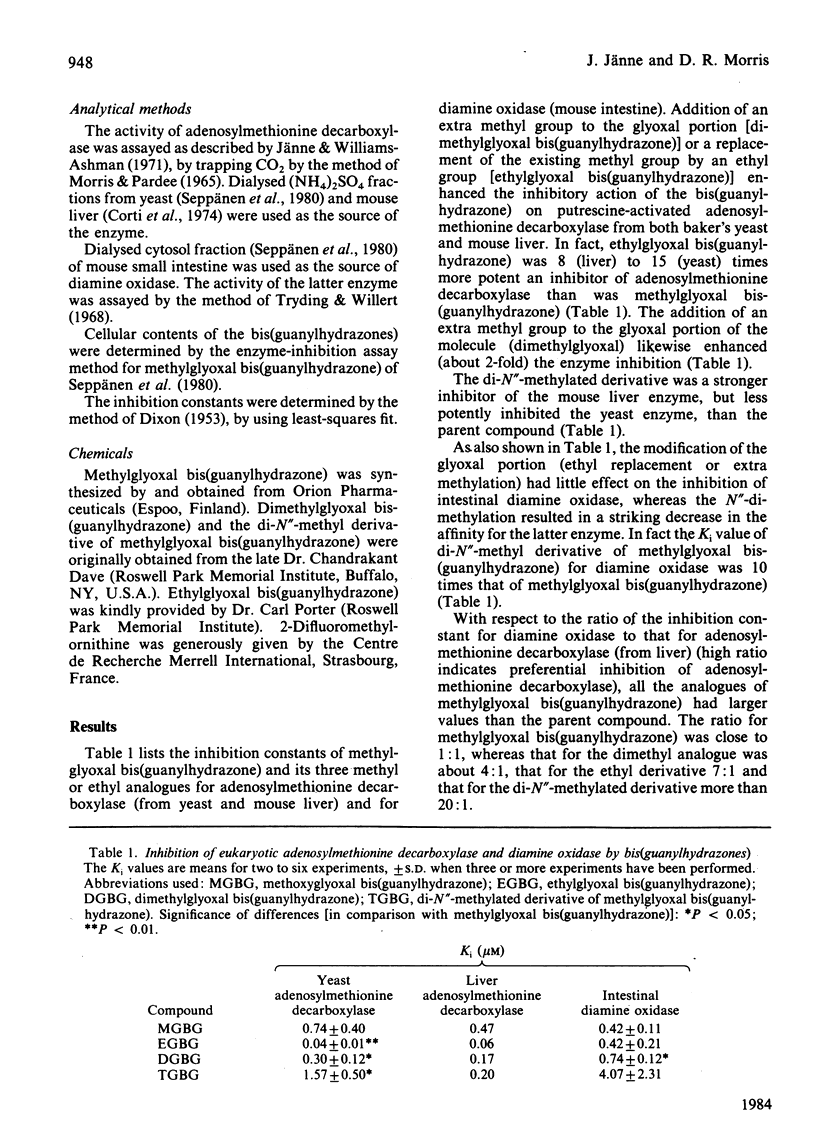
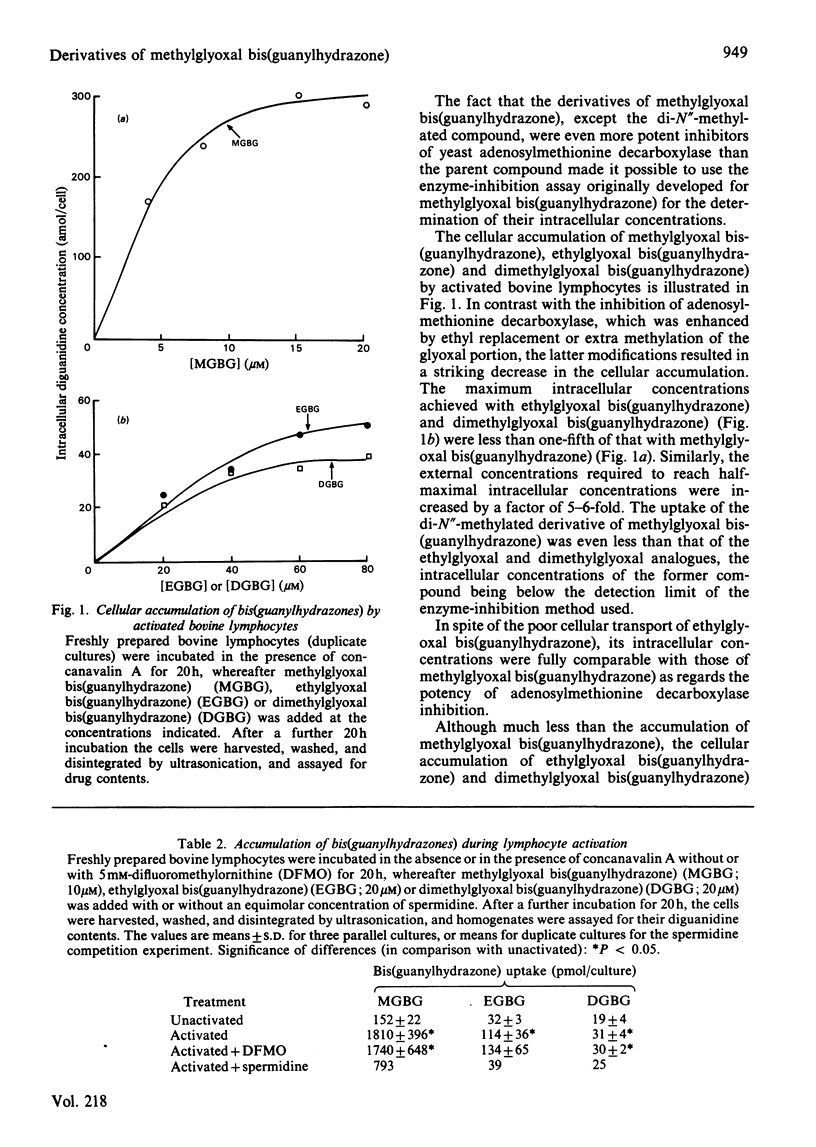
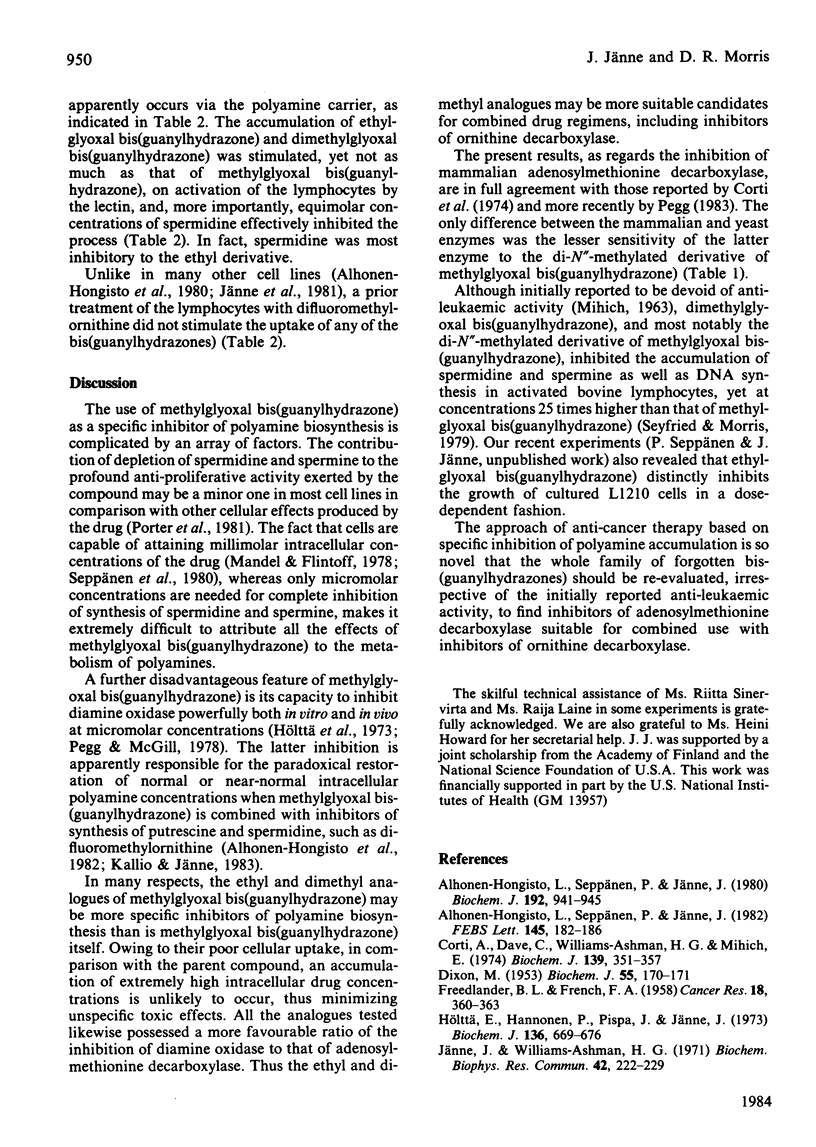
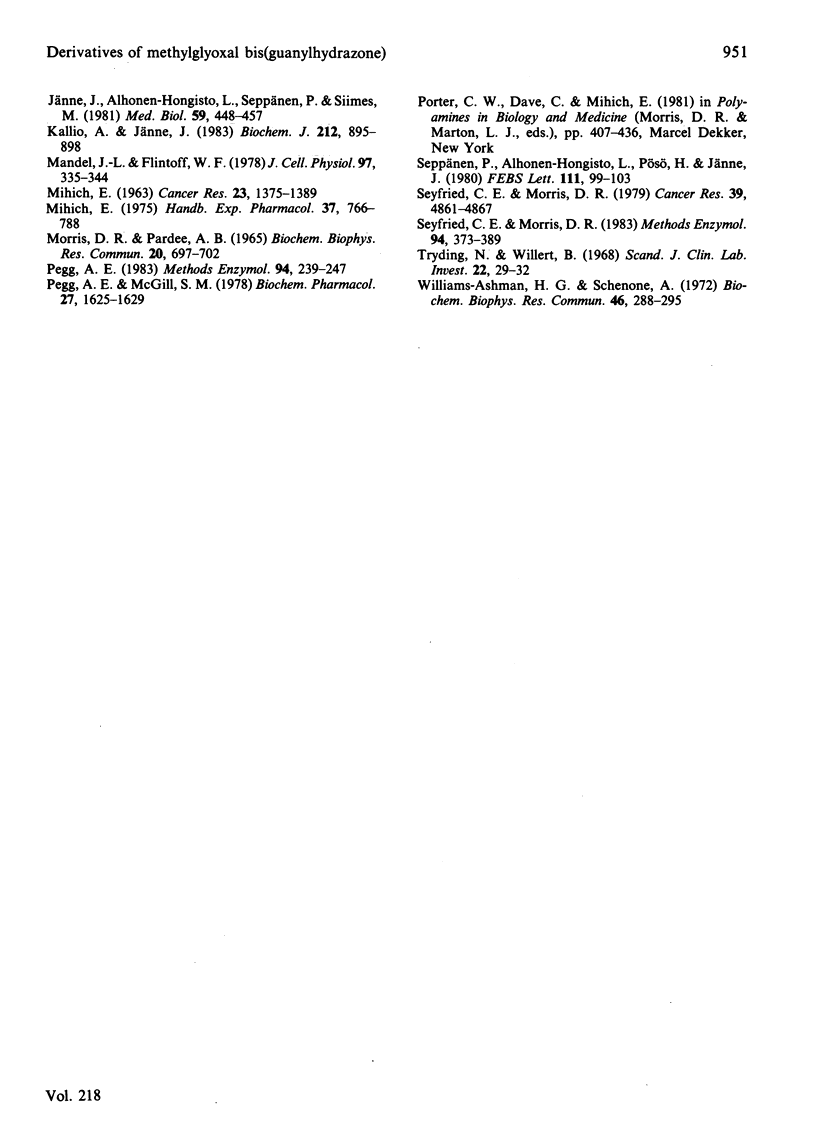
Selected References
These references are in PubMed. This may not be the complete list of references from this article.
- Alhonen-Hongisto L., Seppänen P., Jänne J. Intracellular putrescine and spermidine deprivation induces increased uptake of the natural polyamines and methylglyoxal bis(guanylhydrazone). Biochem J. 1980 Dec 15;192(3):941–945. doi: 10.1042/bj1920941. [DOI] [PMC free article] [PubMed] [Google Scholar]
- Alhonen-Hongisto L., Seppänen P., Jänne J. Methylglyoxal bis(guanylhydrazone) stimulates the cellular transport system of the polyamines. FEBS Lett. 1982 Aug 23;145(2):182–186. doi: 10.1016/0014-5793(82)80163-4. [DOI] [PubMed] [Google Scholar]
- Corti A., Dave C., Williams-Ashman H. G., Mihich E., Schenone A. Specific inhibition of the enzymic decarboxylation of S-adenosylmethionine by methylglyoxal bis(guanylhydrazone) and related substances. Biochem J. 1974 May;139(2):351–357. doi: 10.1042/bj1390351. [DOI] [PMC free article] [PubMed] [Google Scholar]
- DIXON M. The determination of enzyme inhibitor constants. Biochem J. 1953 Aug;55(1):170–171. doi: 10.1042/bj0550170. [DOI] [PMC free article] [PubMed] [Google Scholar]
- FREEDLANDER B. L., FRENCH F. A. Carcinostatic action of polycarbonyl compounds and their derivatives. II. Glyoxal bis (guanylhydrazone) and derivatives. Cancer Res. 1958 Apr;18(3):360–363. [PubMed] [Google Scholar]
- Hölttä E., Hannonen P., Pispa J., Jänne J. Effect of methylglyoxal bis(guanylhydrazone) on polyamine metabolism in normal and regenerating rat liver and rat thymus. Biochem J. 1973 Nov;136(3):669–676. doi: 10.1042/bj1360669. [DOI] [PMC free article] [PubMed] [Google Scholar]
- Jänne J., Alhonen-Hongisto L., Seppänen P., Siimes M. Use of polyamine antimetabolites in experimental tumours and in human leukemia. Med Biol. 1981 Dec;59(5-6):448–457. [PubMed] [Google Scholar]
- Jänne J., Williams-Ashman H. G. Dissociation of putrescine-activated decarboxylation of S-adenosyl-L-methionine from the enzymic synthesis of spermidine and spermine by purified prostatic enzyme preparations. Biochem Biophys Res Commun. 1971 Jan 22;42(2):222–229. [PubMed] [Google Scholar]
- Kallio A., Jänne J. Role of diamine oxidase during the treatment of tumour-bearing mice with combinations of polyamine anti-metabolites. Biochem J. 1983 Jun 15;212(3):895–898. doi: 10.1042/bj2120895. [DOI] [PMC free article] [PubMed] [Google Scholar]
- MIHICH E. CURRENT STUDIES WITH METHYLGLYOXAL-BIS(GUANYLHYDRAZONE). Cancer Res. 1963 Sep;23:1375–1389. [PubMed] [Google Scholar]
- Mandel J. L., Flintoff W. F. Isolation of mutant mammalian cells altered in polyamine transport. J Cell Physiol. 1978 Dec;97(3 Pt 1):335–343. doi: 10.1002/jcp.1040970308. [DOI] [PubMed] [Google Scholar]
- Morris D. R., Pardee A. B. A biosynthetic ornithine decarboxylase in Escherichia coli. Biochem Biophys Res Commun. 1965 Sep 22;20(6):697–702. doi: 10.1016/0006-291x(65)90072-0. [DOI] [PubMed] [Google Scholar]
- Pegg A. E. Inhibitors of S-adenosylmethionine decarboxylase. Methods Enzymol. 1983;94:239–247. doi: 10.1016/s0076-6879(83)94042-9. [DOI] [PubMed] [Google Scholar]
- Pegg A. E., McGill S. M. Inhibition of diamine oxidase by 1,1-[(methylethanediylidene)-dinitrilo]-bis-(3-aminoguanidine) and 1,1'-[(methylethanediylidene)-dinitrilo]-diguanidine. Biochem Pharmacol. 1978;27(12):1625–1629. doi: 10.1016/0006-2952(78)90170-3. [DOI] [PubMed] [Google Scholar]
- Seppänen P., Alhonen-Hongisto L., Pösö H., Jänne J. Sensitive enzymic determination of methylglyoxal bis(guanylhydrazone) in cultured cells and in animal tissues. FEBS Lett. 1980 Feb 25;111(1):99–103. doi: 10.1016/0014-5793(80)80770-8. [DOI] [PubMed] [Google Scholar]
- Seyfried C. E., Morris D. R. Methods for the study of the physiological effects of inhibitors of polyamine biosynthesis in mitogen-activated lymphocytes. Methods Enzymol. 1983;94:373–389. doi: 10.1016/s0076-6879(83)94067-3. [DOI] [PubMed] [Google Scholar]
- Seyfried C. E., Morris D. R. Relationship between inhibition of polyamine biosynthesis and DNA replication in activated lymphocytes. Cancer Res. 1979 Dec;39(12):4861–4867. [PubMed] [Google Scholar]
- Tryding N., Willert B. Determination of plasma diamine oxidase (histaminase) in clinical practice. A comparison between a biological method and a radiochemical micromethod. Scand J Clin Lab Invest. 1968;22(1):29–32. doi: 10.3109/00365516809160732. [DOI] [PubMed] [Google Scholar]
- Williams-Ashman H. G., Schenone A. Methyl glyoxal bis(guanylhydrazone) as a potent inhibitor of mammalian and yeast S-adenosylmethionine decarboxylases. Biochem Biophys Res Commun. 1972 Jan 14;46(1):288–295. doi: 10.1016/0006-291x(72)90661-4. [DOI] [PubMed] [Google Scholar]


